If you’re looking for a loyal and reliable guard dog, proper training is essential. Guard dogs are trained to protect their owners and property, making them a valuable asset. However, training a guard dog requires patience, consistency, and specialized techniques. In this comprehensive guide, we’ll provide step-by-step instructions on how to train a guard dog effectively, so you can unleash your pet’s potential to protect your home and family.
- Proper training is essential for a loyal and reliable guard dog
- Training a guard dog requires patience, consistency, and specialized techniques
- This guide will provide step-by-step instructions on how to train a guard dog effectively
- Unleash your pet’s potential to protect your home and family
- With proper training, your guard dog can be a valuable asset
Understanding Guard Dog Training Techniques
Guard dog training requires a specific set of techniques to ensure a well-rounded approach to your dog’s training. While traditional training techniques such as punishment and scolding may have been used in the past, modern dog training methods focus on positive reinforcement and behavior training. Effective dog training should involve understanding your dog’s behavior and using that knowledge to shape their responses through training techniques that encourage learning rather than fear.
Positive reinforcement training is one of the most highly recommended guard dog training techniques. This technique involves rewarding your dog for good behavior instead of punishing them for bad behavior. Rewards can include treats, praise, or affection, which motivates your dog to repeat the good behavior. Positive reinforcement can help establish a positive learning environment for your dog, making it easier for them to learn new commands and behaviors.
Behavior training is another essential technique in guard dog training. This method involves shaping specific behaviors through positive reinforcement, repetition, and consistency. For example, if you want to teach your dog to sit, you would use positive reinforcement to encourage the desired behavior, such as giving them a treat when they sit on command. Consistency is key to any behavior training, so it’s important to repeat the same commands and use the same rewards each time to help your dog understand the desired behavior.
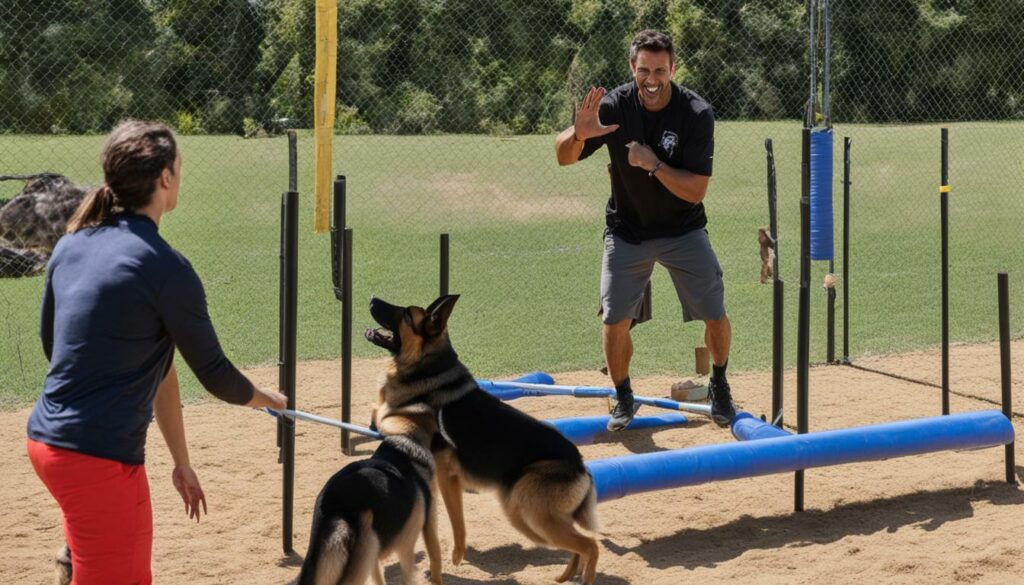
Effective guard dog training requires a combination of different techniques. By understanding and using positive reinforcement and behavior training, you can establish a strong foundation for your dog’s training. It’s important to remember that patience, consistency, and a positive attitude are key to effective dog training. With the right techniques, your dog can become a loyal, confident, and effective guard dog.
Establishing Dog Obedience Training Basics
Before diving into specific guard dog training techniques, it’s important to establish a foundation of obedience training. This will help your dog understand their role in the training process and create a positive learning environment.
The first step in obedience training is teaching basic commands, such as “sit,” “stay,” and “come.” These commands will help you gain control over your dog and create a sense of trust between you and your pet.
Positive reinforcement is key in obedience training. This means rewarding your dog’s good behavior with treats, praise, and attention. Using positive reinforcement will encourage your dog to repeat desirable behaviors and create a positive association with the training process.
It’s important to be consistent with your commands and rewards when training your dog. Use the same commands every time and be patient with your dog as they learn. Consistency will help them understand what is expected of them and reinforce the training.
Remember, obedience training is an ongoing process. Practice regularly to maintain your dog’s skills and continue to reinforce positive behaviors. By establishing a foundation of obedience training, you will set your guard dog up for success in their overall training process.
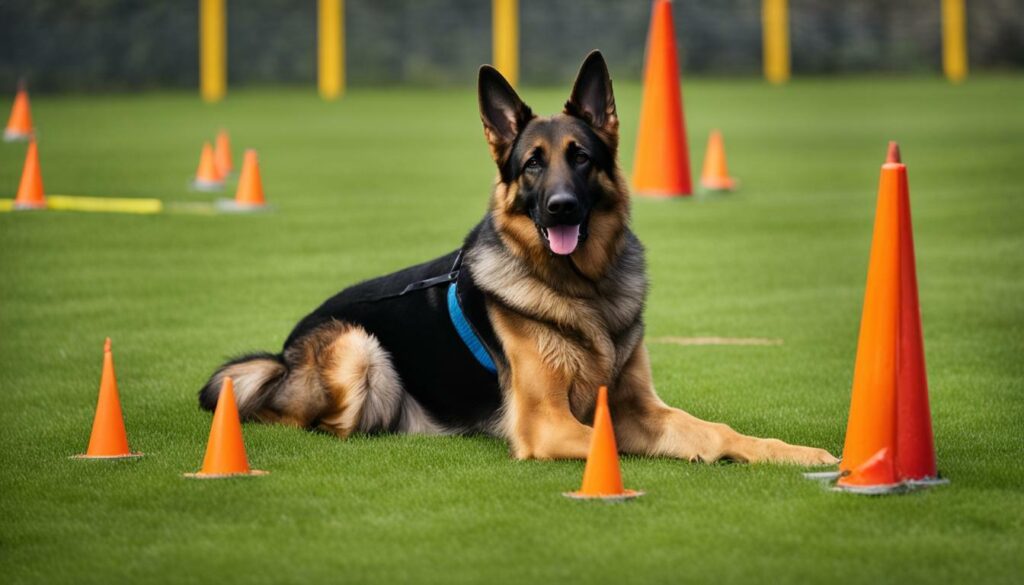
In order for your dog to be an effective guard dog, it is essential to train them to exhibit specific behaviors. These behaviors include alerting you to potential threats, maintaining focus and self-control, and remaining calm in high-stress situations.
Positive reinforcement is a powerful tool to use when training your dog to exhibit these behaviors. One effective technique is to reward your dog for exhibiting the desired behavior, such as staying alert and barking when someone approaches your property. When your dog receives positive feedback, they are more likely to repeat the behavior.
It is important to note that when training guard dog behaviors, you should never encourage aggression in your dog. Instead, focus on rewarding alertness, self-control, and confidence.
One effective technique to train your dog to remain calm in stressful situations is to expose them to various stimuli, such as loud noises or unfamiliar people. Start with low-intensity stimuli and gradually increase the intensity as your dog becomes more confident and comfortable.
Another essential behavior for a guard dog is to maintain focus even in distracting environments. This can be trained by gradually exposing your dog to distractions, such as toys or treats, and teaching them to ignore them and focus on their training.
Overall, developing guard dog behaviors requires patience, consistency, and positive reinforcement. With the proper training techniques, your dog can become a reliable and effective protector for your home and family.
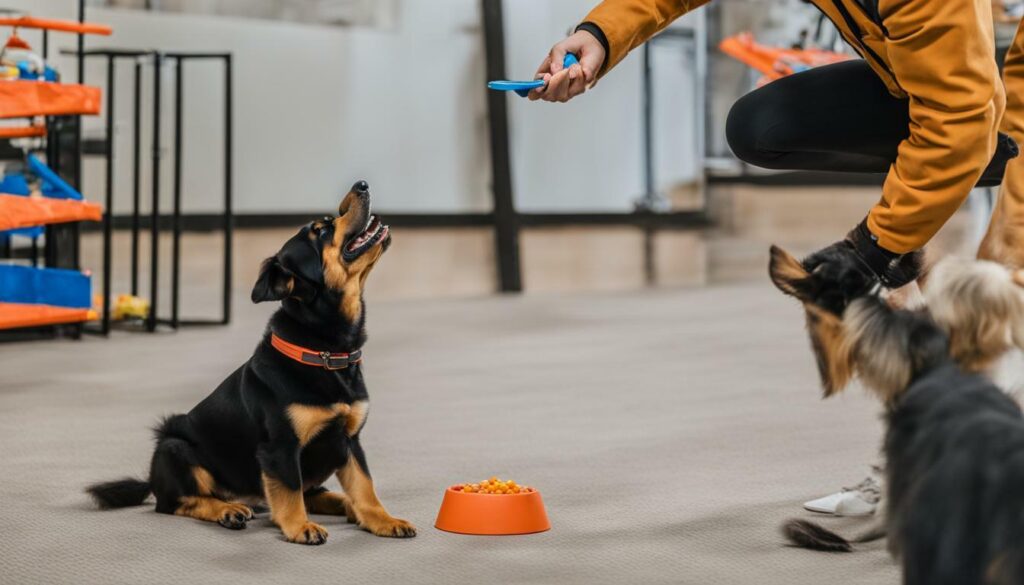
Socialization is a crucial aspect of guard dog training, as it helps your dog build confidence and remain well-behaved in various situations. Positive reinforcement training is an effective method to socialize your dog and train them to behave appropriately around people and other animals.
To begin the socialization process, introduce your dog to various environments, such as parks, sidewalks, and public spaces. Gradually increase the level of distraction and exposure over time to help your dog adapt to different environments. Reward your dog with praise or treats for exhibiting positive behavior, such as staying calm and maintaining focus.
When introducing your dog to new people and animals, always supervise and provide positive guidance. Teach your dog to greet others politely and calmly, without jumping or excessive barking. Reward your dog for exhibiting good behavior and avoid punishing them for mistakes or misbehavior.
Remember, socializing your guard dog is an ongoing process that requires patience, consistency, and positive reinforcement. By following these training tips, you can help your dog build confidence and become a well-behaved protector for your home and family.
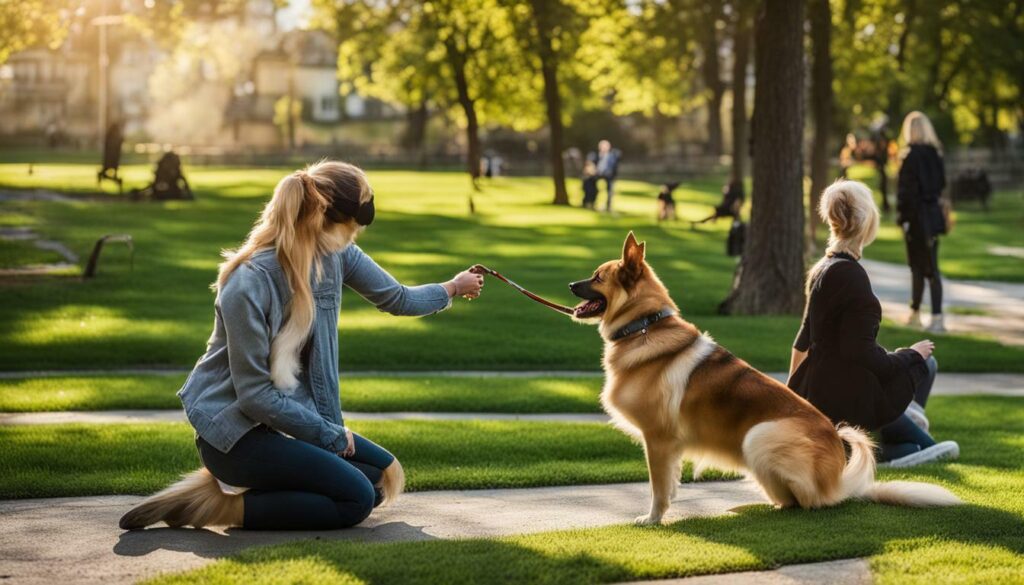
Proper equipment is an essential element of effective guard dog training. The right equipment can help you control your dog’s behavior and provide a safe environment for both you and your pet. Here are the types of equipment you will need:
| Equipment Type | Description |
|---|---|
| Leash and Collar | A sturdy leash and collar are essential for controlling your dog’s movements. Choose a high-quality leather or nylon leash and a collar that fits well and is comfortable for your dog to wear. |
| Body Harness | A harness provides more control over your dog’s movements and can help distribute pressure more evenly across their body. Choose a durable, well-fitted harness that is comfortable for your dog to wear. |
| Bite Sleeve | A bite sleeve is a padded arm sleeve used for advanced training, such as teaching your dog to attack on command. Choose a high-quality sleeve that fits well and is comfortable for your dog to bite. |
| Muzzle | A muzzle is a safety precaution that can prevent your dog from biting or chewing on inappropriate objects. Choose a muzzle that fits well and allows your dog to breathe and drink comfortably. |
When introducing equipment to your dog, it’s important to do so gradually and with plenty of positive reinforcement. Start by giving your dog a chance to sniff and explore the equipment without putting it on. Then, gradually introduce each piece of equipment one at a time, using treats and positive reinforcement to encourage your dog to wear it.
Professional dog training can be beneficial when it comes to selecting the right equipment and introducing it to your dog safely. A professional trainer can also help you develop a training plan that incorporates the use of equipment effectively.
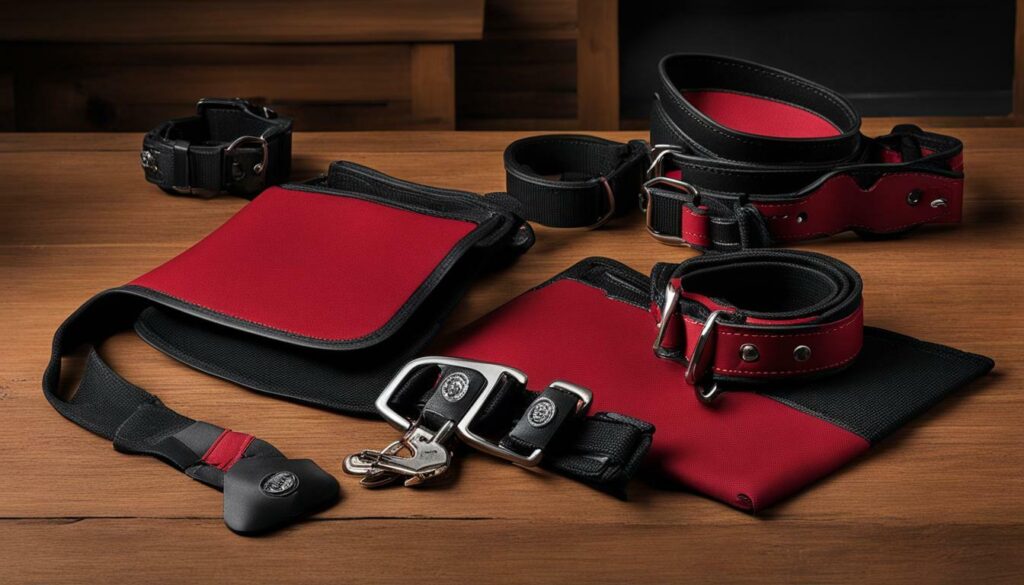
Once your dog has mastered the basics, it’s time to move on to more advanced skills that will make them an even more effective guard dog. These skills will help your dog respond to specific situations and potential threats, making them an invaluable asset to your home and family’s safety.
To develop these advanced skills, you will need to continue using positive reinforcement techniques and a consistent training routine. Here are some essential skills to work on:
| Skills | Description |
|---|---|
| Guard Command | This command tells your dog to guard a specific area or object. With consistent practice, your dog will learn to recognize the command and respond appropriately, such as barking or standing guard. |
| Release Command | This command tells your dog to release their hold or stop guarding. It is essential to teach this command to ensure your dog doesn’t continue guarding unnecessarily and knows when it’s time to stop. |
| Scent Detection | Teaching your dog to recognize specific scents can be extremely useful in identifying potential threats. Start by introducing your dog to a particular scent and rewarding them for recognizing it. Gradually increase the difficulty level and reward them for identifying the correct scent when presented with multiple options. |
| Bark on Command | Teaching your dog to bark on command can be useful in alerting others to potential threats. Start by saying the command and encouraging your dog to bark. Reward them once they’ve barked on command and gradually increase the difficulty level by introducing distractions. |
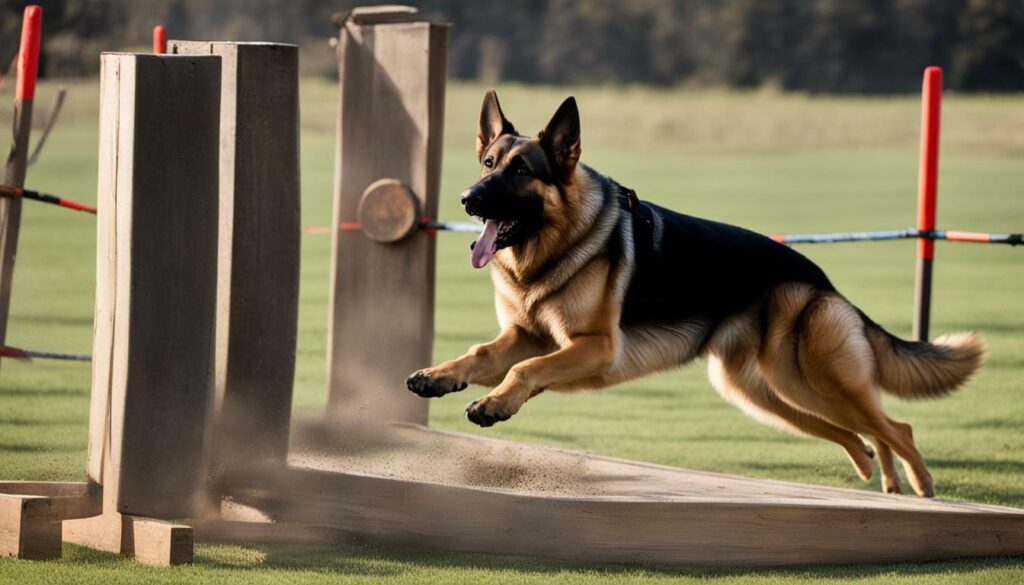
Remember, developing these advanced skills requires patience, consistency, and positive reinforcement. Keep in mind that training should always be a positive experience for your dog, and never use punishment or negative reinforcement methods.
Professional dog training may be necessary to develop these advanced skills. Consider seeking help from a professional trainer who specializes in guard dog training if you encounter any challenges or difficulties along the way.
Maintaining a Consistent Training Routine
Consistency is key in training a guard dog. Once you have established a training routine, it’s important to stick to it and ensure that everyone in the household is on board.
Set aside a regular time each day for training sessions and make sure that your dog is well-rested and hasn’t eaten a big meal beforehand. Keep training sessions short and focused, and end on a positive note with plenty of praise and rewards.
It’s also important to be consistent with your commands and rewards. Use the same words and gestures each time you give a command, and be sure to reward your dog immediately after they perform the desired behavior.
Positive reinforcement is a powerful tool in maintaining a consistent training routine. Focus on rewarding good behavior rather than punishing bad behavior, and be patient and persistent in your training efforts.
Finally, remember to have fun and enjoy the process of training your guard dog. Your dog will sense your enthusiasm and will be more motivated to learn and perform at their best.
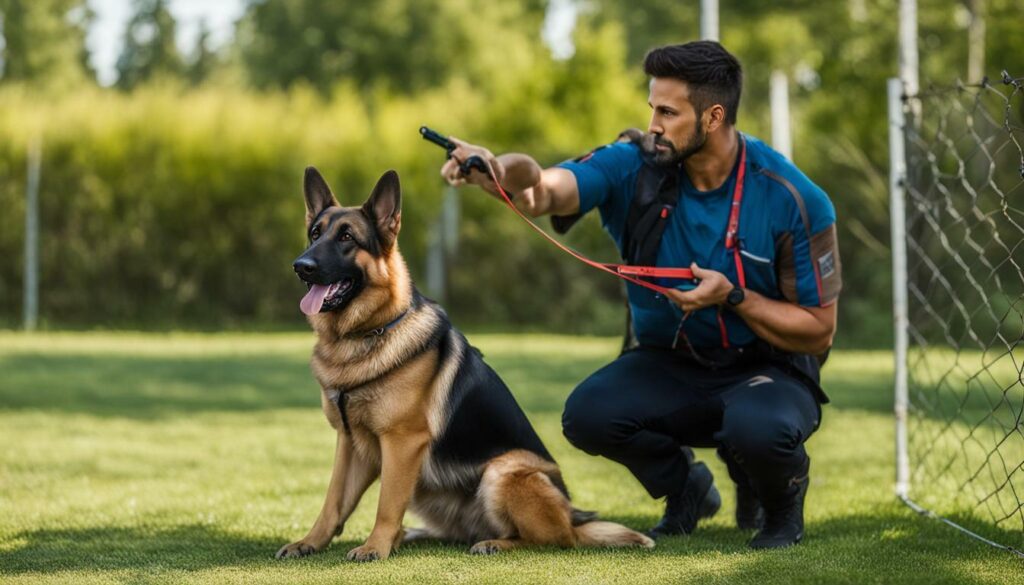
By maintaining a consistent training routine and using positive reinforcement techniques, you can help your guard dog reach their full potential as a protector for your home and family.
Dealing with Challenges and Behavioral Issues
Dog training can be a challenging process, and it’s not uncommon to experience problems along the way. However, it’s important to remember that many behavioral issues can be resolved with patience, consistency, and the right approach. In this section, we will explore some common challenges you may encounter while training your guard dog and provide guidance on how to overcome them.
Aggression
Aggression is a common issue in guard dog training, as these dogs are often trained to be protective and assertive. However, it’s important to differentiate between appropriate and inappropriate forms of aggression. While a guard dog should be confident and willing to protect their owners, they should never be unpredictable or dangerous to those they are meant to protect. If your dog is demonstrating signs of inappropriate aggression, it’s important to address the issue immediately.
Positive reinforcement training is an effective way to address aggression in dogs. By rewarding positive behavior and redirecting negative behavior, you can teach your dog to act appropriately in different situations. Consistency is key, so make sure to maintain a regular training routine to reinforce good behavior.
Fear
Fear is another common issue in guard dog training. While it’s natural for dogs to be cautious in new or unfamiliar situations, excessive fear can hinder their ability to perform their duties effectively. It’s important to expose your dog to a variety of situations and environments during their training, to help them build confidence and become more comfortable in different settings.
Positive reinforcement can also be effective in addressing fear in dogs. By rewarding your dog for positive behavior and gradually introducing them to new situations, you can help them overcome their fears and become more confident and well-adjusted.
Distraction
Distraction is another common issue in guard dog training. Dogs naturally have a short attention span, and it’s important to keep training sessions short and focused to maintain their focus and attention. If your dog is easily distracted, it may be helpful to train them in quiet, isolated locations at first, before gradually introducing them to more distracting environments.
Positive reinforcement training can also help address distraction in dogs. By rewarding good behavior and redirecting them when they become distracted, you can help them maintain their focus and attention during training.
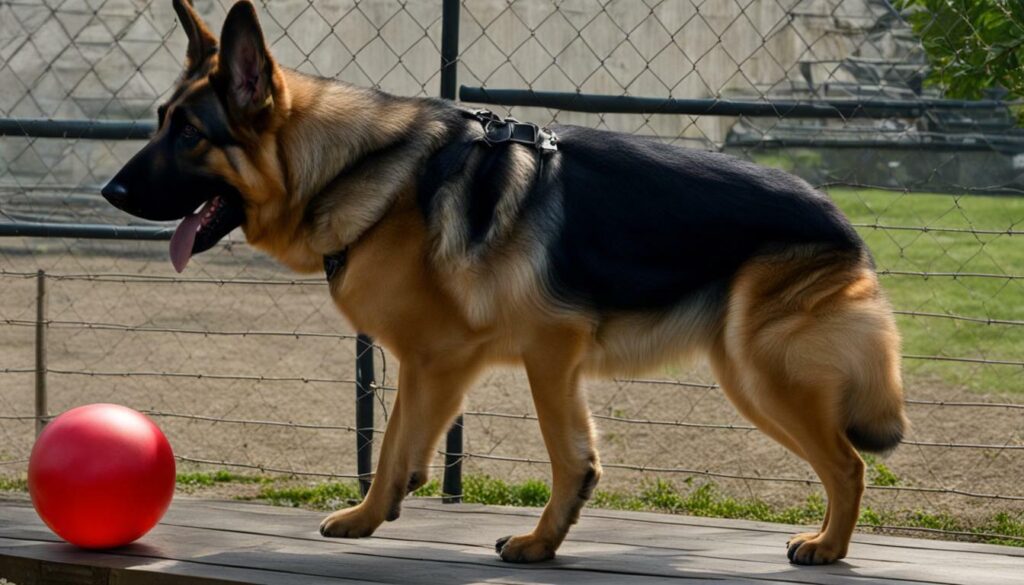
By keeping these tips in mind and remaining patient and consistent, you can overcome challenges and behavioral issues during guard dog training. Remember to always prioritize your dog’s well-being and safety, and seek professional help if needed.
Understanding the Importance of Positive Reinforcement
Positive reinforcement is a training technique that focuses on rewarding desired behaviors rather than punishing negative ones. It is a highly effective method that creates a positive learning environment and encourages your dog to repeat favorable behaviors.
As opposed to traditional training methods that rely on punishment and correction, positive reinforcement reinforces good behaviors through rewards such as treats, praise, and playtime. This technique builds trust and strengthens the bond between you and your dog.
Positive reinforcement training is particularly effective in guard dog training because it encourages your dog to remain focused, calm, and alert to potential threats. By rewarding your dog for behaviors such as barking at strangers or staying alert during a walk, you can reinforce their natural protective instincts and develop their guard dog skills.
It’s essential to remember that positive reinforcement should be used consistently and in conjunction with other training techniques, such as obedience training and behavior shaping. A well-rounded approach to training is crucial to ensuring a well-behaved and effective guard dog.
By highlighting and rewarding good behaviors, positive reinforcement training strengthens your bond with your dog and encourages them to become confident and effective guard dogs.
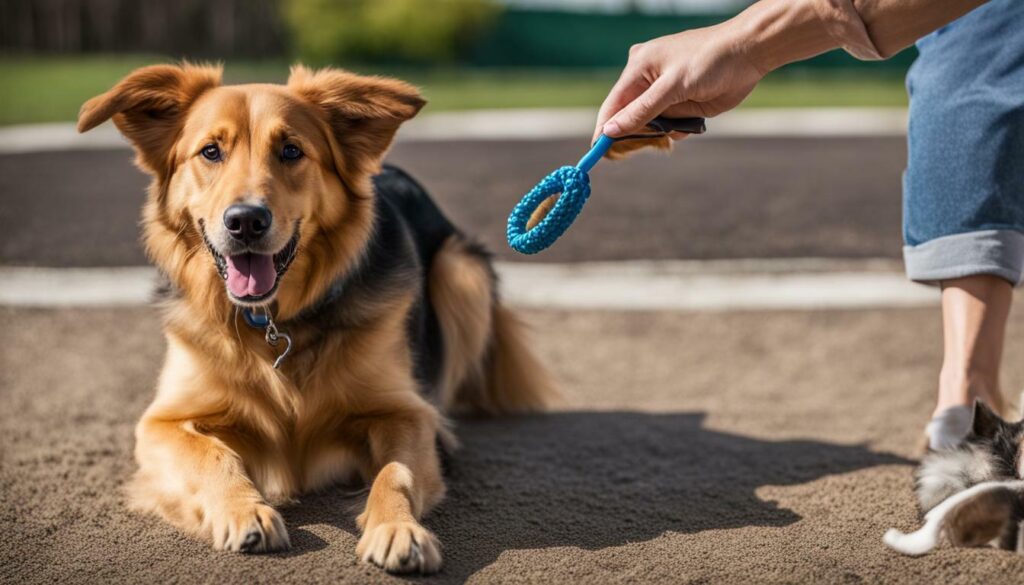
Fine-tuning Your Guard Dog’s Performance
Once your guard dog has mastered the basics of obedience and behavior training, it’s time to fine-tune their performance to make them an even more effective protector. This requires advanced techniques that focus on improving their response time, accuracy, and overall effectiveness as a guard dog.
One of the most important aspects of fine-tuning your guard dog’s performance is practicing and reinforcing their training every day. Consistency is key in maintaining their skills and ensuring they remain alert and focused at all times.
Another strategy is to introduce more complex commands that require your dog to think and act quickly in various situations. These commands may include “search,” “track,” or “speak,” to help your dog identify and respond to potential threats more effectively.
It’s also important to practice scenarios that mimic real-life situations, such as a potential intruder entering your home. This will allow your dog to apply their training in a practical setting and help them remain calm and focused under pressure.
Your dog’s physical fitness is another important aspect of their performance as a guard dog. Regular exercise, such as daily walks or runs, can help them build endurance and improve their overall health.
Finally, it’s essential to maintain a positive, encouraging training environment to keep your guard dog motivated and engaged. Consistently rewarding good behavior and providing plenty of praise and affection will help your dog feel confident and appreciated, making them a more effective protector.
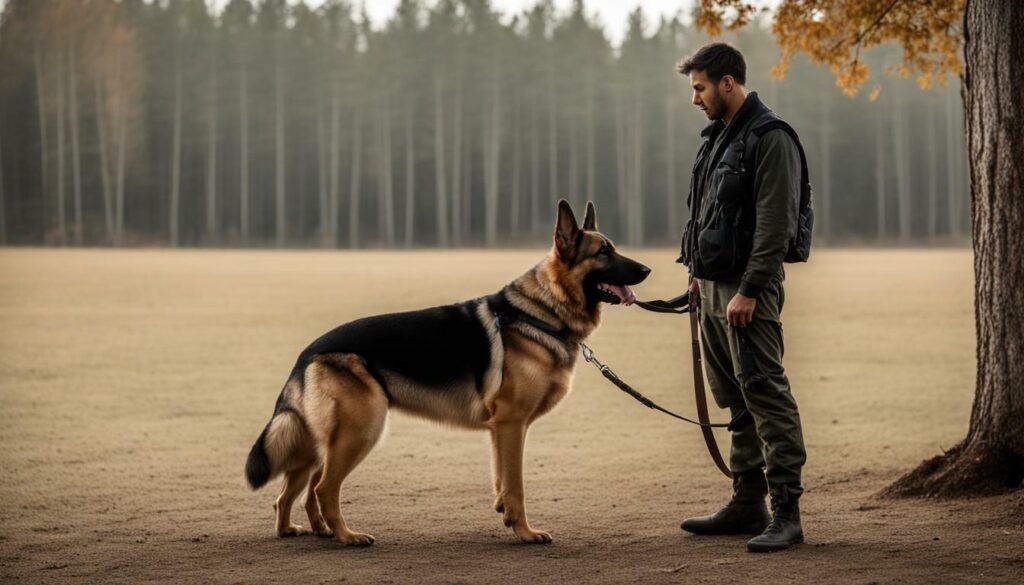
Professional dog training is essential for those looking to train a guard dog. Working with a reputable trainer who has experience in guard dog training will ensure that your dog is trained safely and responsibly. It is important to choose a trainer who uses positive reinforcement methods and has a deep understanding of canine behavior and training techniques.
During guard dog training, safety should always be a top priority. It is important to use appropriate training equipment, such as bite sleeves and harnesses, and to introduce them slowly and safely to your dog. Additionally, be sure to always supervise your dog during training sessions to prevent any accidents or injuries.
Responsible training also means being aware of your dog’s physical and emotional needs. Adequate exercise, nutrition, and rest are all essential for your dog’s well-being and ability to learn. It is also important to recognize when your dog may be experiencing stress or discomfort during training and adjust accordingly.
Overall, responsible and safe training practices will ensure that your guard dog is trained effectively and remains a happy and healthy companion for years to come.
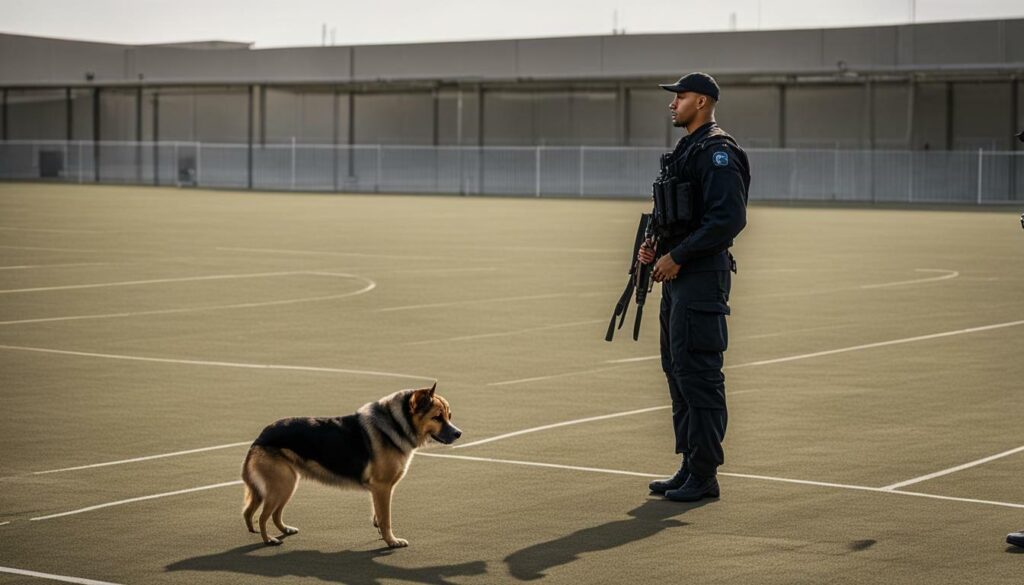
Regularly evaluating and celebrating your guard dog’s progress is essential in maintaining their motivation and keeping them engaged in their training. Here are some tips on how to assess their skills, track their development, and reward their efforts.
First, create a checklist of the skills and behaviors you want your guard dog to exhibit. This can include basic obedience commands, advanced protection skills, and socialization behaviors. Keep track of their progress in each area, noting areas of improvement and areas that may need more attention.
You can also track their development through regular training sessions and mock scenarios. Set up different scenarios to test their response time, accuracy, and overall effectiveness as a protection dog. This can include simulated home invasions or attacks, or having them perform commands in various environments and situations.
When your guard dog meets a milestone or achieves a particular goal, be sure to reward their efforts. This can include verbal praise, treats, or playtime. Positive reinforcement is a powerful motivator for dogs and will help solidify their training and maintain their progress.
As you continue to train your guard dog, be sure to regularly reassess their skills and progress. This will help you identify areas that need more attention and adjust your training methods accordingly. Remember, training is an ongoing process, and consistent evaluation and reinforcement will ensure that your guard dog remains an effective protector for your home and family.
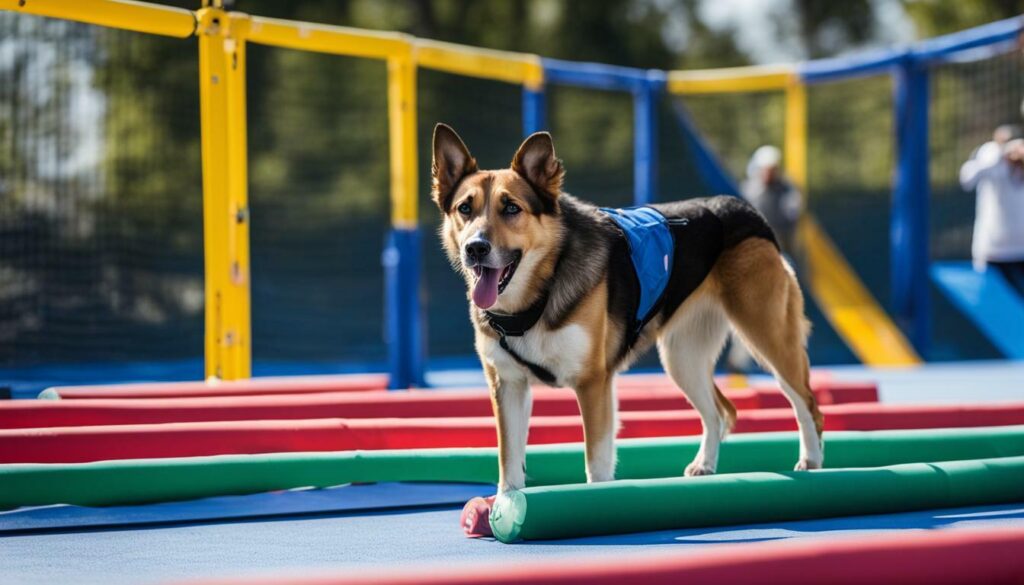
Training a guard dog is an ongoing process that requires consistent effort to maintain their skills and behavior. Here are some essential dog training tips to help you keep your guard dog’s training on track:
1. Practice Regularly
Consistency is key when it comes to maintaining your dog’s training. Set aside regular training sessions and practice their commands in different environments, so they are prepared for any situation that may arise.
2. Use Positive Reinforcement
Positive reinforcement is one of the most effective dog training techniques. Reward your dog for good behavior, and be sure to praise and encourage them during training sessions. This will keep them motivated and engaged.
3. Stay Alert to Behavioral Changes
Pay attention to any changes in your dog’s behavior and address any issues as soon as they arise. This can help prevent small problems from becoming significant challenges that require more extensive retraining.
4. Incorporate Challenges
To keep your dog engaged, incorporate new challenges into their training routine. This could include practicing commands in unfamiliar places or introducing them to new people and animals.
5. Keep it Fun
Training should be a positive experience for both you and your dog. Incorporate playtime and fun activities into their training sessions to keep them interested and engaged.
6. Seek Professional Help When Needed
If you encounter significant behavioral issues or challenges that you are not equipped to handle, don’t hesitate to seek the help of a professional dog trainer. They can provide expert guidance and support to ensure your dog’s training stays on track.
By following these dog training tips and maintaining a consistent training routine, you can ensure that your guard dog remains a reliable and effective protector for your home and family.
FAQ
What is this guide about?
This guide is about training a guard dog step by step, providing instructions on how to effectively train your dog to protect your home and family.
What training techniques are used in guard dog training?
Various techniques are used in guard dog training, including positive reinforcement and behavior training.
What are the basics of dog obedience training?
The basics of dog obedience training involve teaching commands such as sit, stay, and come, using positive reinforcement as a training method.
What behaviors should a guard dog develop?
A guard dog should develop behaviors such as alertness, focus, and self-control, which will be covered in this guide.
Why is socializing a guard dog important?
Socializing a guard dog is important to ensure they remain confident and well-behaved in different environments, around people, and with other animals.
What equipment is needed for guard dog training?
Proper equipment, such as leashes, collars, bite sleeves, and harnesses, is essential for effective guard dog training.
What advanced skills can a guard dog develop?
A guard dog can develop advanced skills, including commands like “guard” and “release” to respond to different situations and threats.
How can I maintain a consistent training routine?
Tips and strategies on establishing and maintaining a consistent training routine will be provided to ensure your dog’s progress and reinforcement of their training.
How can I deal with challenges and behavioral issues during training?
Common challenges and behavioral issues such as aggression, fear, and distractions will be addressed, offering guidance on how to handle and overcome them during the training process.
Why is positive reinforcement important in guard dog training?
Positive reinforcement is crucial in guard dog training as it helps motivate and strengthen desired behaviors, and we will provide tips on using it effectively.
How can I fine-tune my guard dog’s performance?
Advanced techniques will be explored to improve your guard dog’s response time, accuracy, and overall effectiveness as a protection dog.
What safety considerations should I keep in mind during training?
Important safety considerations and responsible training practices will be discussed to ensure the well-being of both you and your dog throughout the training process.
How can I evaluate and celebrate my guard dog’s progress?
Guidance will be provided on how to assess your guard dog’s skills, track their development, and reward their efforts to keep them motivated and engaged.
How can I maintain my guard dog’s training?
The final section of this guide will discuss how to maintain and reinforce your guard dog’s training throughout their life to ensure they remain a reliable and effective protector.
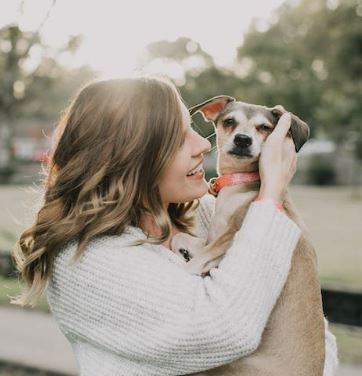
Marissa Delotta, 36, from Dayton, Ohio, is the creative force behind Roverboard.com, a beloved online destination for dog lovers. As a dedicated mom and canine enthusiast, Marissa combines her family experiences with her love for dogs to offer a platform where dog owners can exchange tips, heartwarming stories, and advice. Her website has become a vibrant community for sharing the joys of dog parenting. In her free time, Marissa enjoys exploring dog parks with her family and volunteering at local animal shelters.